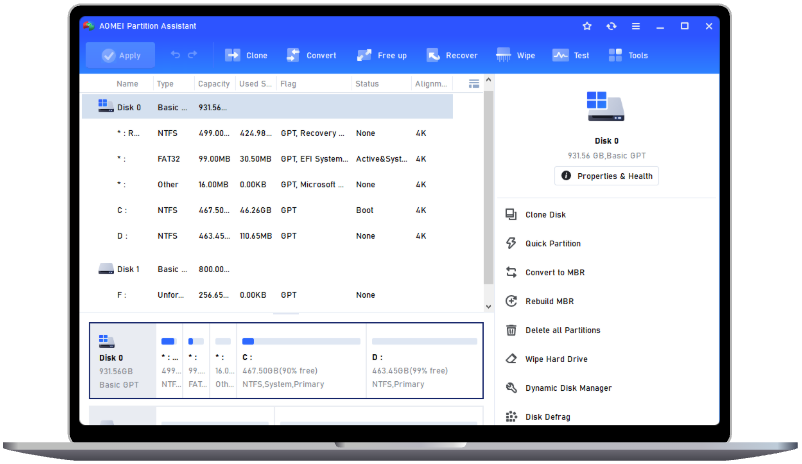How to Repartition the Windows Partition Without Rebooting: Step-by-Step Guide
This guide provides a step-by-step method to repartition the Windows partition without rebooting, allowing you to resize, create, or merge partitions effortlessly while the system is running.
Can I Repartition a Hard Disk Without Restarting?
Over time, you might run out of space on the system drive while other partitions remain underutilized, or you may need to create a new partition for better data organization. Repartitioning allows you to resize, merge, or split partitions without losing data. This can optimize disk space usage and improve system performance.
Repartitioning is not difficult, especially for non-system drives. However, if you're trying to shrink or extend the partition where Windows is installed, some changes might require a restart, particularly if files are in use.
"Can I repartition my hard disk without rebooting?" Absolutely! This guide provides a step-by-step method to repartition the Windows partition without rebooting, helping you efficiently manage your disk space.
How to Repartition the Windows Partition Without Rebooting?
Windows includes built-in tools like Disk Management for resizing partitions. However, when modifying the system partition (C: drive), a restart may be required in the following cases:
- Shrinking the C: drive when system files prevent resizing.
- Extending the C: drive without available adjacent unallocated space.
- Performing operations that affect boot-related files.
But don’t worry! Third-party partitioning tools like AOMEI Partition Assistant allows you to repartition your hard disk (including both system and non-system drives) without rebooting. With a few clicks, you can easily adjust the partition size. This professional and user-friendly software not only supports resizing partitions but also offers multiple advanced features for simplified disk management, such as disk formatting, disk cloning, or OS migrating.
- Why Choose AOMEI Partition Assistant?:
- Supports resizing (shrinking or extending) both NTFS and FAT32 partitions.
- Enables partition alignment for SSDs, helping to optimize performance.
- Easily extends a partition with nonadjacent space on the same disk.
- Fully compatible with Windows 11, 10, 8.1, 8, and 7.
Let’s use AOMEI Partition Assistant to repartition the Windows partition without rebooting:
Option 1. One-Click Adjust Partition Space
AOMEI Partition Assistant provides a “1-Click Adjust Space” feature, allowing you to flexibly adjust partition space by simply dragging the dots at the partition’s head or tail. This lets you easily modify the disk layout without data loss.
Step 1. Install and launch AOMEI Partition Assistant. Right-click a partition (here is D: partition) you want to adjust space and select "1-Click Adjust Space".
Step 2. If you want to use the space on F: to expand D:, you can simply drag the dot near the partition F: head backward to shrink the partition F: and enlarge the partition D: drive. Then click "OK".
At the same time, you can drag the dot near the partition C: tail forward to shrink the partition C: so the D: will also be enlarged with the space of C. In this case, you can adjust all partition space (C:, D:, and F:) on the disk.
Step 3. Then, click "Apply" and "Proceed" to start the repartition process.
Step 4. The process will start and you can check the progress. It might take time to finish the operation.
Step 5. Wait for the operation to be finished. After it is completed successfully, you will find D: is enlarged and both D: and F: are adjusted.
Option 2. Allocate Free Space
Alternatively, you can use the “Allocate Free Space” feature to extend your system partition. It allows you to directly reallocate space from one partition to another without manual adjustment.
Step 1. Launch AOMEI Partition Assistant, right-click the partition (here is D: partition) which you want to allocate free space from, and select "Allocate Free Space".
Step 2. In the pop-up window, you can type the free space that you want to cut from the D: partition and specify the target partition (Here is C: partition).
Step 3. Step 3. Then, click "Apply" and "Proceed" to start the repartition process.
Step 4. After it is completed successfully, you will find C: is extended.
Additional Tips for Safe Repartitioning
Repartitioning your hard disk can be a delicate process, so following best practices is crucial to prevent data loss or system errors. Here are some essential tips for safe repartitioning:
✔️ Back Up Important Data: Before making any partition changes, ensure you back up critical files to an external drive or cloud storage.
✔️ Check Available Space: Always verify that there is enough free space before resizing or merging partitions.
✔️ Avoid Interruptions: Ensure your system has a stable power supply to prevent accidental shutdowns during partition operations.
Conclusion
Repartitioning a hard disk is a practical solution for managing disk space. However, when modifying the system partition (C: drive), a restart may be required. Fortunately, AOMEI Partition Assistant allows you to repartition your Windows partition without rebooting, making disk management more effortless and efficient!
FAQs
Q1: Is it safe to repartition the Windows partition without rebooting?
Yes, as long as you use a reliable tool and follow proper precautions like backing up important data.
Q2: Do I need to format my hard drive before repartitioning?
No, formatting is not necessary unless you want to create a new file system from scratch.
Q3: How long does it take to repartition a hard disk?
The time required depends on the partition size and the type of operation, but most changes are completed within minutes.


